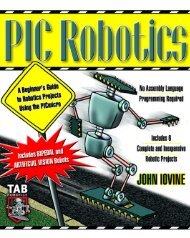Sensors and Methods for Mobile Robot Positioning
Sensors and Methods for Mobile Robot Positioning
Sensors and Methods for Mobile Robot Positioning
You also want an ePaper? Increase the reach of your titles
YUMPU automatically turns print PDFs into web optimized ePapers that Google loves.
134 Part II Systems <strong>and</strong> <strong>Methods</strong> <strong>for</strong> <strong>Mobile</strong> <strong>Robot</strong> <strong>Positioning</strong><br />
One should note that another popular test<br />
path, the “figure-8” path [Tsumura et al.,<br />
1981; Borenstein <strong>and</strong> Koren, 1985; Cox,<br />
1991] can be shown to have the same shortcomings<br />
as the uni-directional square path.<br />
5.2.1.2 The Bidirectional Square-Path<br />
Experiment<br />
The detailed example of the preceding section<br />
illustrates that the unidirectional square<br />
path experiment is unsuitable <strong>for</strong> testing<br />
odometry per<strong>for</strong>mance in differential-drive<br />
plat<strong>for</strong>ms, because it can easily conceal two<br />
mutually compensating odometry errors. To<br />
overcome this problem, Borenstein <strong>and</strong> Feng<br />
[1995a; 1995c] introduced the bidirectional<br />
square-path experiment, called University<br />
of Michigan Benchmark (UMBmark).<br />
UMBmark requires that the square path<br />
experiment be per<strong>for</strong>med in both clockwise<br />
<strong>and</strong> counterclockwise direction. Figure 5.4<br />
shows that the concealed dual error from<br />
the example in Figure 5.3 becomes clearly<br />
visible when the square path is per<strong>for</strong>med<br />
in the opposite direction. This is so because<br />
the two dominant systematic errors, which<br />
may compensate <strong>for</strong> each other when run<br />
in only one direction, add up to each other<br />
<strong>and</strong> increase the overall error when run in<br />
the opposite direction.<br />
The result of the bidirectional squarepath<br />
experiment might look similar to the<br />
one shown in Figure 5.5, which presents<br />
actual experimental results with an off-theshelf<br />
TRC LabMate robot [TRC] carrying<br />
an evenly distributed load. In this experi<br />
ment the robot was programmed to follow<br />
a 4×4 meter square path, starting at (0,0).<br />
The stopping positions <strong>for</strong> five runs each in<br />
clockwise (cw) <strong>and</strong> counterclockwise<br />
(ccw) directions are shown in Figure 5.5.<br />
Note that Figure 5.5 is an enlarged view of<br />
the target area. The results of Figure 5.5<br />
can be interpreted as follows:<br />
Reference Wall<br />
Start<br />
End<br />
Rob ot<br />
Curved instead of straight path<br />
(due to unequal wheel diameters).<br />
In the example here, this causes<br />
a 3 o orientation error.<br />
Start<br />
93 o turn instead of 90 o turn<br />
(due to uncertainty about the<br />
effective wheelbase).<br />
Preprogrammed<br />
square path, 4x4 m.<br />
\designer\book\deadre30.ds4, deadre31.wmf, 07/19/95<br />
Figure 5.3: The effect of the two dominant systematic<br />
dead-reckoning errors E b <strong>and</strong> E d . Note how both errors<br />
may cancel each other out when the test is per<strong>for</strong>med in<br />
only one direction.<br />
Preprogrammed<br />
square path, 4x4 m.<br />
Curved instead of straight path<br />
(due to unequal wheel diameters).<br />
In the example here, this causes<br />
a 3 o orientation error.<br />
93 o o<br />
turn instead of 90 turn<br />
(due to uncertainty about<br />
the effective wheelbase ).<br />
End<br />
\designer\book\deadre30.ds4, deadre32.w mf, 07/19/95<br />
Reference Wall<br />
Figure 5.4: The effect of the two dominant systematic<br />
odometry errors E b <strong>and</strong> E d : when the square path is<br />
per<strong>for</strong>med in the opposite direction one may find that the<br />
errors add up.<br />
93 o




